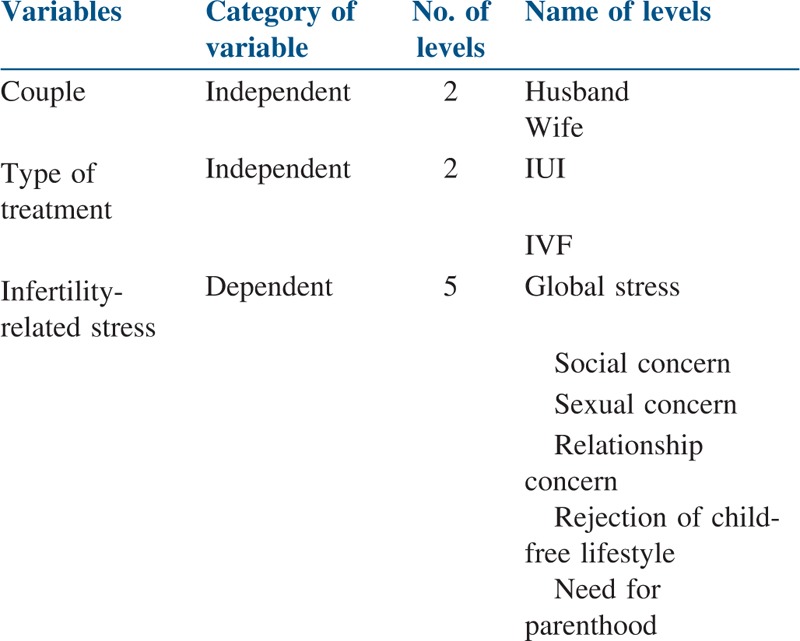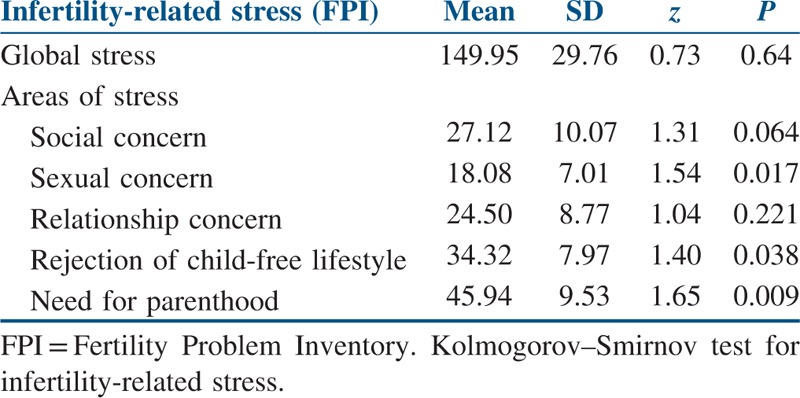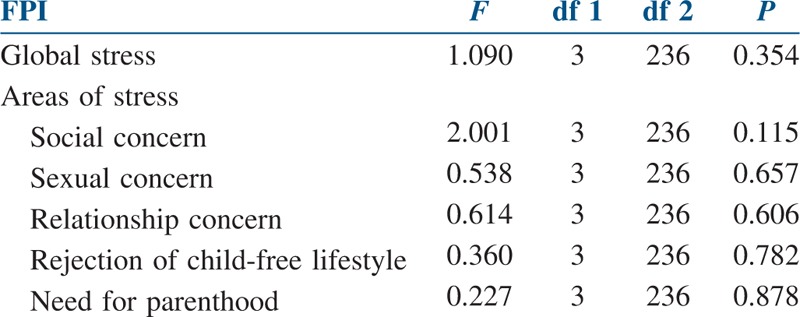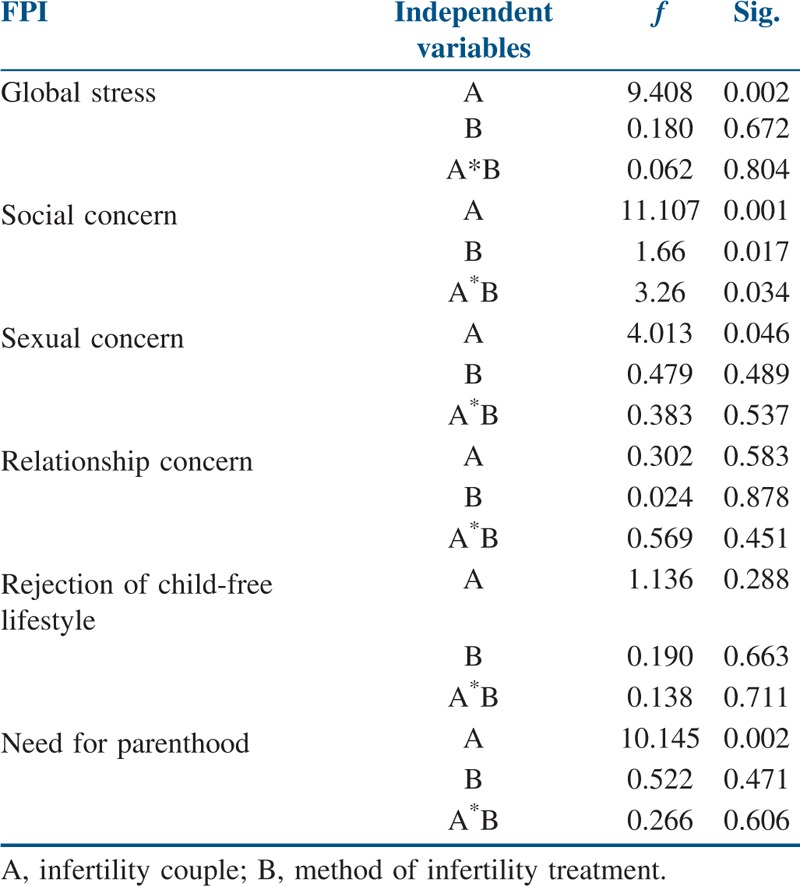Abstract
Aim:
The main aim of the study was to assess the stress levels of husbands and wives undergoing intrauterine insemination (IUI) and in vitro fertilization (IVF) treatments, and also to observe whether the stress levels differed between the methods of treatments.
Materials and Methods:
This research focused on 120 infertile couples who underwent IUI and In Vitro Fertilization-Intra Sperm Cytoplasmic sperm Injection (IVF-ICSI) at an infertility clinic from April 2014 to November 2014. Sixty couples who underwent each method of treatment were selected using purposive sampling technique. Fertility Problem Inventory (Newton et al., 1999) was used to collect the data after obtaining their consent.
Statistical Analysis:
Statistical analysis was performed at descriptive (mean, standard deviation, and Kolmogorov test) and inferential (analysis of variance, ANOVA) levels.
Results and Conclusion:
The prevalence of global stress was very high in couples undergoing IUI and IVF treatments, as found by descriptive analysis [mean = 149.95, standard deviation (SD) = 29.76]. Considering the various subscales, stress related to the need for parenthood was found to be high (mean = 45.95, SD = 9.53). Infertility stress (global) was higher among wives when compared to their husbands (f = 9.408; P = 0.002), and the same was noted on the domains of need for parenthood (f = 10.145; P = 0.002), social concern (f = 11.107; P = 0.001), and sexual concern (f = 4.013; P = 0.046). No difference in the levels of global stress was observed when both the modes of treatments were compared (f = 0.180, P = 0.672). For couples, infertility stress showed no significant difference irrespective of whether they underwent IUI or IVF.
KEYWORDS: Infertility stress, intrauterine insemination, in vitro fertilization, need for parenthood, sexual concern, social concern
INTRODUCTION
Infertility has been recognized as a public health issue worldwide by the World Health Organization (WHO).[1] Most of the married couples in India wish to become parents, and they believe that they will be able to do so, by the biological route, whenever they wish. These couples tend to become depressed, angry at their fate, frustrated, develop guilty feelings and blame their destiny, if fertility fails. Each year, millions of couples are affected by infertility. Infertility is considered as a life crisis affecting a couple’s self-esteem, personal relationship, health, and wealth as well. Globally, infertility affects 50–80 million couples at some point in their reproductive lives.[2] India accounts for 5–10 million of the infertile couples, and the number is increasing at the rate of 5% every 2 years.[3] The WHO estimates the overall prevalence of primary infertility in India to be between 3.9% and 16.8%.[4] Each couple has a unique experience because of infertility, because their stress levels differ. Such couples undergoing treatments keep worrying about not to stress themselves, which stresses them all the more. Intrauterine insemination (IUI) and in vitro fertilization (IVF) include many transvaginal sonograms every now and then, causing awkwardness for the woman. These treatments include taking hormones either through injections or orally, which may result into many side effects such as headache, nausea, and hot flushes. The husbands have to masturbate to produce the semen either in the laboratory or in the hospital or have to bring it from home within half an hour in a container, making them feel very embarrassed. These couples along with their family bounce between hope and despair. For one moment, they are full of hope and very optimistic that the treatment would be a success for them, and the very next moment, they become gloomy and pessimistic and feel what if it does not work for them?
Deka and Swarnali conducted a study that addressed the psychological aspects of infertility. They showed that among infertile couples, women were more distressed than their male partners.[5] Sreshthaputra et al.[6] studied infertility-related stress present in both men and women and also examined its relationship with their level of perceived social support.[6] In this study, the stress levels of both male and female participants were high in the subscales of sexual concern, relationship concern, as well as the need for parenthood, and moderate stress was observed in the subscales scores of social concern and the rejection of childless lifestyle. Global stress was high for the participants, and there was no significant difference among males and females. Positive correlation was found between the global stress scores of infertile females and their partners (r = 0.562, P = 0.000).[6]
MATERIALS AND METHODS
The main aim of the study was to assess the infertility-related stress for couples who underwent IUI and IVF treatments. The following objectives were laid for the purpose:
-
(1)
To study the level of infertility-related stress in couples undergoing IUI and IVF-ICSI.
-
(2)
To explore the variance in infertility-related stress among couples having infertility problem and undergoing treatment for infertility.
-
(3)
To explore the variation in infertility-related stress among infertile couples with regard to their method of treatment.
-
(4)
To study the difference in infertility-related stress among the couples (husband and wife) in relation to either of the infertility treatments involved in, that is IUI or IVF.
Sample selection
In this study, the considered sample included diagnosed infertile couples attending an infertility clinic. Hundred and fifty couples who underwent IUI or IVF were approached for data collection. Among them, 125 couples consented; however, the data of five couples were discarded because it was incomplete. Therefore, finally, the sample comprised 120 couples. Couple selection per treatment was equally distributed. Nonprobability purposive sampling technique was used to collect the data.
Inclusion criteria
-
(1)
Couples selected were diagnosed as infertile by the gynecologist.
-
(2)
They had no prior children.
-
(3)
Undergoing IUI or IVF for the first or second time.
-
(4)
Aged between 21 and 50 years.
Exclusion criteria
-
(1)
Unwilling to participate in the study.
-
(2)
Unable to understand English, Hindi, or Gujarati.
-
(3)
Couples with any psychopathology present in them.
Sample size
Considering the approximate treatment cycles performed during the period of data collection in the infertility clinic and owing to the inclusion and exclusion criteria, the sample size was calculated (120 couples/240 participants) with confidence interval being 5 at 95% confidence level. In addition to that, the published studies[6,7] on the related topic had a similar sample size.
Variables
The independent variables under study were couple (husband and wife) and the type of treatment (IUI and IVF). Infertility-related stress (social concern, sexual concern, relationship concern, rejection of child-free lifestyle, and need for parenthood) was the dependent variable [Table 1].
Table 1.
The variables under study

Research design
The research design used to study the objectives was 2*2 factorial design [Table 2].
Table 2.
2 × 2 factorial design used to study the objectives laid

Tool used
The tool used to measure the level of stress was Fertility Problem Inventory (FPI). This test was apt for the sample under study. It was developed by Dr. Christopher Newton in the year 1999.[8] The test had five subscales, namely social concern, sexual concern, relationship concern, rejection of a child-free lifestyle, and need for parenthood. The overall stress is described as global stress. The questionnaire contained 46 items. It was a six-point Likert scale ranging from “strongly disagree” to “strongly agree.” A Cronbach’s alpha for each item with its dimension was found as 0.801, which indicated a strong reliability.
Procedure
A pilot study of 10 couples was first conducted to check the feasibility of the research topic. For data collection, rapport was built with the couples, consent was obtained, and then data were collected in a quiet room of the hospital; confidentiality was maintained for the collected data. Finally, the data were scored using the standardized scoring pattern of the test.
Statistical analysis
Descriptive (mean and standard deviation) and explorative (Kolmogorov–Smirnov test) statistics were calculated for the dependent variable. Analysis of variance (ANOVA) was computed for gender difference of infertile couples (wives and husbands) and the type of treatments (IUI and IVF) on the measure of infertility-related stress among the considered couples. The statistics was calculated using the Statistical Package for the Social Sciences version 17.0 software (SPSS Inc., Chicago, IL, United States).
RESULTS
The mean score on the measure of infertility-related stress was found as 149.95, which revealed the prevalence of very high stress among these couples. While considering different domains of infertility-related stress, the obtained mean score revealed incidence of higher stress among the couples in this study on the subscale of need for parenthood [M = 45.94; standard deviation (SD) = 9.53], which was subsequently followed by the rejection of child-free lifestyle (M = 34.32; SD = 7.97), relationship concern (M = 24.50; SD = 8.77), social concern (M = 27.12; SD = 10.07), and sexual concern (M = 18.08; SD = 7.01) [Table 3].
Table 3.
Summary of descriptive (mean and SD) and explorative analyses

Additionally, the explorative analysis, z value (Kolmogorov–Smirnov test), revealed the data for infertility-related stress (z = 0.73; P = 0.64) and for its different aspects, namely social concern (z = 1.31; P = 0.064) and relationship concern (z = 1.04; P = 0.221), as normally distributed [Table 3].
Inferential analysis
The results obtained by ANOVA revealed the effect of gender difference among couples and method of treatment for infertility-related stress (FPI) for infertile couples undergoing IUI or IVF treatment. As in explorative analysis, the obtained data for infertility stress were not normally distributed; f value (Leaven’s test) was employed to ascertain the equality of error variance across the groups, which reflected the required assumptions of ANOVA for these considered data.
The obtained mean score for all experimental groups (A1B1, A1B2, A2B1, and A2B2) on the measure of their infertility-related stress related to social concern (A1B1 = 29.27, A1B2 = 29.20, A2B1 = 24.80, and A2B2 = 25.20), sexual concern (A1B1 = 19.02, A1B2 = 18.95, A2B1 = 17.77, and A2B2 = 16.58), and the rejection of child-free lifestyle (A1B1 = 34.90, A1B2 = 34.83, A2B1 = 34.18, and A2B2 = 33.35) area revealed that it was higher for wives as compared to husbands irrespective of the method of infertility treatment they were involved in. As far as relationship concern is concerned, high prevalence was seen in the wives undergoing IVF treatment (M = 25.33). The obtained mean score on the measure of stress experienced due to their need for parenthood was found to be higher for wives, particularly those undergoing IUI treatment procedure (M = 48.62); this was subsequently followed by wives undergoing IVF treatment (M = 47.12), husbands with IUI (M = 44.13), and then husbands with the IVF mode of treatment (M = 43.88) [Table 4].
Table 4.
Summary of mean and standard deviation (SD) of all the experimental groups on all the subscales of Fertility Problem Inventory (FPI)

The Leaven’s test (f value) was found to be insignificant for all the subscales as well as global scale [Table 5], which showed that the error variance in the groups was said to be equal; in other words, the required assumptions of ANOVA were conformed for this not normally distributed data.
Table 5.
Summary of Leaven's test of equality of error variances for all the subscales of Fertility Problem Inventory (FPI)

The computed f values for the gender difference among couples, the method of treatments, and its interaction on the measure of stress showed significant difference only for gender disparity in the areas of social concern (f = 11.107; P = 0.001), sexual concern (f = 4.013; P = 0.046), need for parenthood (f = 10.145; P = 0.002), and global stress (f = 9.408; P = 0.002) [Table 6].
Table 6.
Summary of analysis of variance in 2 × 2 factorial design for all the subscales of Fertility Problem Inventory (FPI)

DISCUSSION
This study confirmed the findings to be consistent with a wide body of literature conducted abroad; however, very few studies of this sort have been done in India. While both males and females reported infertility as a stressful experience, females perceived it as more stressful and generally seemed to be more affected in terms of negative life consequences.[9] In another similar study, when the intensity of stress among infertile couples was compared, it was seen that wives showed higher levels of distress than their husbands.[10] Women face social stigma more compared to men because of stereotypical cultural expectations. Women do not openly talk about their sexual life and sexual desires. When involved in the treatment, women feel as if they discuss their bedroom life with doctors, and they are not comfortable doing it. They have a dream to be a mother; therefore, when under treatment, their levels of need for parenthood are higher compared to their husbands, because they are in a state of disbelief. Overall, their stress is higher compared to their husbands because of the societal pressure. Females also experience a sense of rejection. The infertility treatments are associated with a woman’s body; therefore, they suffer physically more.
IUI and IVF treatments involve a lot of uncertainty, making it equally stressful for the couple. Therefore, there was no significant difference found among couples involved in any of this treatment. In addition, both these treatments can drain a couple financially, emotionally, and physically; therefore, the level of stress experienced is almost the same. The prevalence of infertility-related stress cannot be attributed only on the type of treatment, as other factors that are associated with infertility treatment were also identified in different studies as causing stress among this infertility cohort. For instance, in a study it was found that infertility-related stress appeared to increase after any unsuccessful treatment. In their study, an examination of women’s stress after treatment divulged higher incidence of stress related to infertility after their 12 months of unsuccessful treatment as compared to those who were recently involved in infertility treatment.[11] A lot of discrepancy is also seen in the literature; therefore, no single conclusion can be drawn.
This research will help psychologists to plan and design proper therapeutic intervention for couples undergoing IUI and IVF. To the health professionals, it justifies the need for a better patient-informed approach that can be established by giving pre- and post-treatment counseling sessions. It also informs the medical fraternity about the need for developing programs for increasing awareness about the problem of infertility and the treatments available for it. Many people are less aware about it and have less ability to accept such treatments because of several misconceptions and beliefs.
This study limits itself by employing purposive sample, because it comprised only those couples who were attending the infertility clinic for their treatment, which causes bias in sample selection and also limits the generalization of findings. In a cross-sectional part of this study, infertility-related stress was studied in relation to the gender disparity of infertile couple and their involvement in either of the infertility treatments, that is IUI and IVF. However, other aspects such as type of infertility, perceived social support, economical status, and culture should have been incorporated in the study.
CONCLUSION
The prevalence of infertility-related stress was found to be very high in couples undergoing infertility treatments. Considering the various subscales, stress related to the need for parenthood was higher.
The f value revealed that infertility stress was higher in wives undergoing infertility treatments when compared to their husbands. It also showed that wives reported higher stress levels on the domains of need for parenthood, social concern, and sexual concern. It also revealed no difference in the stress level, whether as a whole or domain wise, when IUI and IVF modes of treatments were compared. In addition, as far as husbands and wives were concerned, infertility stress, global as well as domain wise, showed no significant difference irrespective of whether they underwent IUI or IVF.
Financial support and sponsorship
Nil.
Conflicts of interest
There are no conflicts of interest.
REFERENCES
- 1.World Health Organisation. Infertility is a Global Public Health Issue. Sexual and Reproductive Health. 2014 [Google Scholar]
- 2.Technical Division of United Nations Population Fund. Methodological Guidelines for the Gender analysis of National Population and Housing Census Data. 1999:87. [Google Scholar]
- 3.Nagaraj A. For a large number of childless couples, life begins in a Petri dish. Indian Express. 2000. [Last accessed on 2017 Feb 17]. Available from: http://shodhganga.inflibnet.ac.in/bitstream/10603/60567/21/21_summary.pdf .
- 4.World Health Organization. DHS Comparative Reports No. 9. Calverton, Maryland, USA: ORC Macro and the World Health Organization; 2004. In Fecundity, Infertility, and Childlessness in Developing Countries. [Google Scholar]
- 5.Deka PK, Swarnali S. Psychological aspects of infertility. BJMP. 2010;3:a336. [Google Scholar]
- 6.Sreshthaputra O, Sreshthaputra R, Vutyavanich T. Gender differences in infertility-related stress and the relationship between stress and social support in Thai infertile couples. J Med Assoc Thai. 2008;91:1769–73. [PubMed] [Google Scholar]
- 7.Link PW, Darling CA. Couples undergoing treatment for infertility: Dimensions of life satisfaction. J Sex Marital Ther. 1986;12:46–59. doi: 10.1080/00926238608415393. [DOI] [PubMed] [Google Scholar]
- 8.Newton C, Sherrarda W, Glavaca I. The Fertility Problem Inventory: Measuring perceived infertility-related stress. Fertil Steril. 1999;72:54–62. doi: 10.1016/s0015-0282(99)00164-8. [DOI] [PubMed] [Google Scholar]
- 9.Greil AL. Infertility and psychological distress: A critical review of the literature. SocSciMed. 1997;45:1679–704. doi: 10.1016/s0277-9536(97)00102-0. [DOI] [PubMed] [Google Scholar]
- 10.Wright J, Duchesne C, Sabourin S, Bissonnette F, Benoit J, Girard Y. Psychological distress and infertility, men and women respond differently. Fertil Steril. 1991;55:100–8. [PubMed] [Google Scholar]
- 11.Schmidt L, Holstein B, Christensen U, Boivin J. Communication and coping as predictors of fertility problem stress: Cohort study of 816 participants who did not achieve a delivery after 12 months of fertility treatment. Hum Reprod. 2005;20:3248–56. doi: 10.1093/humrep/dei193. [DOI] [PubMed] [Google Scholar]


